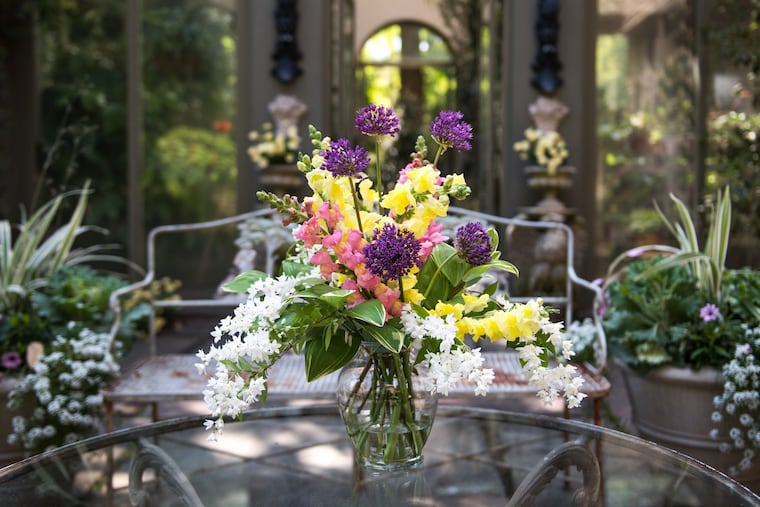Flower arrangement 101: How to make a bouquet from backyard flowers
Cut stems at an angle, pick the right height in a vase, make a Scotch tape grid — and other tips from Philly-area floral designers.

Sitting at a table overlooking the lush gardens of Jenkintown’s Meadowbrook Farm, estate gardener Julie Bare begins to fill a vase. She starts with leafy greens, creating a base for an arrangement. Next are delicate white deutzia that cascade over the edges. At the center, Bare adds a cluster of purple, globe-shaped allium flowers. She threads pink and yellow snapdragons into the empty space.
“If, like myself, you’ve always wanted to do something artistic but were never good at painting or drawing, flower arranging is the perfect activity,” Bare said while cutting a snapdragon stem at an angle. “It’s really a meditative and a creative outlet.”
While less intimidating than oil painting, making a bouquet isn’t as simple as throwing cut flowers into a vase. It takes technique to compose a centerpiece, but with a little knowledge, anyone can do it.
We asked Philly-area floral designers to share their tips on arranging flowers from your own garden. For a hands-on lesson, check out PHS’ Garden to Vase series, on the fourth Thursday of every month at Meadowbrook Farm.
If you go: Pennsylvania Horticultural Society’s Fourth Thursdays - Garden to Vase: Fabulous Flowers, 6 to 7:30 p.m., June 27, $25-$30, 215-988-1698, meadowbrookfarm.org
RETRIEVING FLOWERS
Pick early in the day. “If you sneak up early in the morning, the flowers won’t have undergone the stress of field heat from the sun, and so they’ll last significantly longer,” said Sarah Mikolowsky of East Falls’ Vault + Vine.
Look for flowers that haven’t fully bloomed. “Ones that are just starting to open will recover from being cut quicker and will typically last longer,” said Lynn Schultz of Chadds Ford’s Green Meadows Florist.
Cut stems on an angle. Whenever you cut flowers, do so with a slant. “It’s like a straw — if you put it into a glass straight down, it’s harder to sip in water,” said Claudia Roux of Old City’s Petit Jardin en Ville. “Make sure your scissors are sharp, too, so you don’t crush the stem.”
Use a bucket. Collect the flowers in a bucket filled with a few inches of water. “You want to get the flowers hydrated as soon as possible to prevent wilting,” Bare said. For more complex arrangements, Roux advises leaving the stems in water for half a day at least. “This will give the flowers a little more strength when you start to design with them.”
»READ MORE: The best herbs to grow indoors, according to your light, and how to grow them
BEFORE ARRANGING
Visualize a theme. “When picking out flowers, it can help to think about what adjectives describe each [flower], and choose ones that fit a theme,” Mikolowsky said. “You could go for wild and airy, playful and bright, dramatic and moody, monochromatic.”
Consider using herbs. Herbs can help prop flowers up and lend a nice fragrance, Roux said. “I love rosemary because it has a strong stem, but I also love mint, oregano, and basil — all of which come in a multitude of colors.”
Choose your vessel wisely. “If you want the focus to be more on the flowers, pick a clear-glass utility vase,” Mikolowsky said. “Cool vases from vintage shops or estate sales can add a sculptural appeal of their own.” Choose a vase that’s a third of the height of the overall arrangement you want to make.
»READ MORE: A local succulent expert takes the hippest houseplant to the next level
Strip off lower leaves. “Foliage starts to rot when it gets wet, which creates bacteria that will decrease the lifespan of the flowers,” Bare warns.
DURING ARRANGING
Experiment with what you have. “Test what foliage and flowers will even hold up in a vase,” Mikolowsky suggests. “There are a lot of beautiful roadside flowers — like dandelions — that just don’t last, but plenty of garden flowers not found in floral shops are great.”
Create structure with greens. Use sturdy leaves to make a base for your bouquet. “You want to find foliage that won’t just wilt right away,” Mikolowsky said, citing Japanese maple leaves, smoke bush, and other shrubs and grasses. “Angle it so that it kisses the side of the container, building out so that you hide the lip of the container.”
Position larger flowers next. “Get the focal flowers where you want them, and then add to that with wispier flowers,” Schultz said.
Leave some room. “When everything’s so tightly packed, you can’t see the characteristics of each individual cutting,” Roux said. “Space creates movement for the eye.”
Make a grid. If you want more order, use Scotch tape to create a grid on the mouth of the vase. “Then put the stems in the holes to keep them from moving around,” Roux said. “You can also use a flower frog — it’s a spiky base filled with pins that you stick the stems onto.”
Step back every so often. “When you’re up close and letting yourself get lost in what you’re doing, it can help to step back and look at the overall picture,” Bare said.
»READ MORE: 5 edible plants you can forage for in your backyard, and how to cook them
AFTER ARRANGING
Routine maintenance. Every two days, change the water and recut the stems. “It will significantly increase the lifespan of your arrangement,” Roux said.
Refrigerate for longer life. “If you want to make it on Thursday but have company coming on Sunday, just place it in the fridge,” Bare said. “Keep the vase away from produce items though, since certain ones release a gas that speeds up flowers’ aging process.”
»READ MORE: The 10 air-purifying indoor plants that are easiest to keep alive